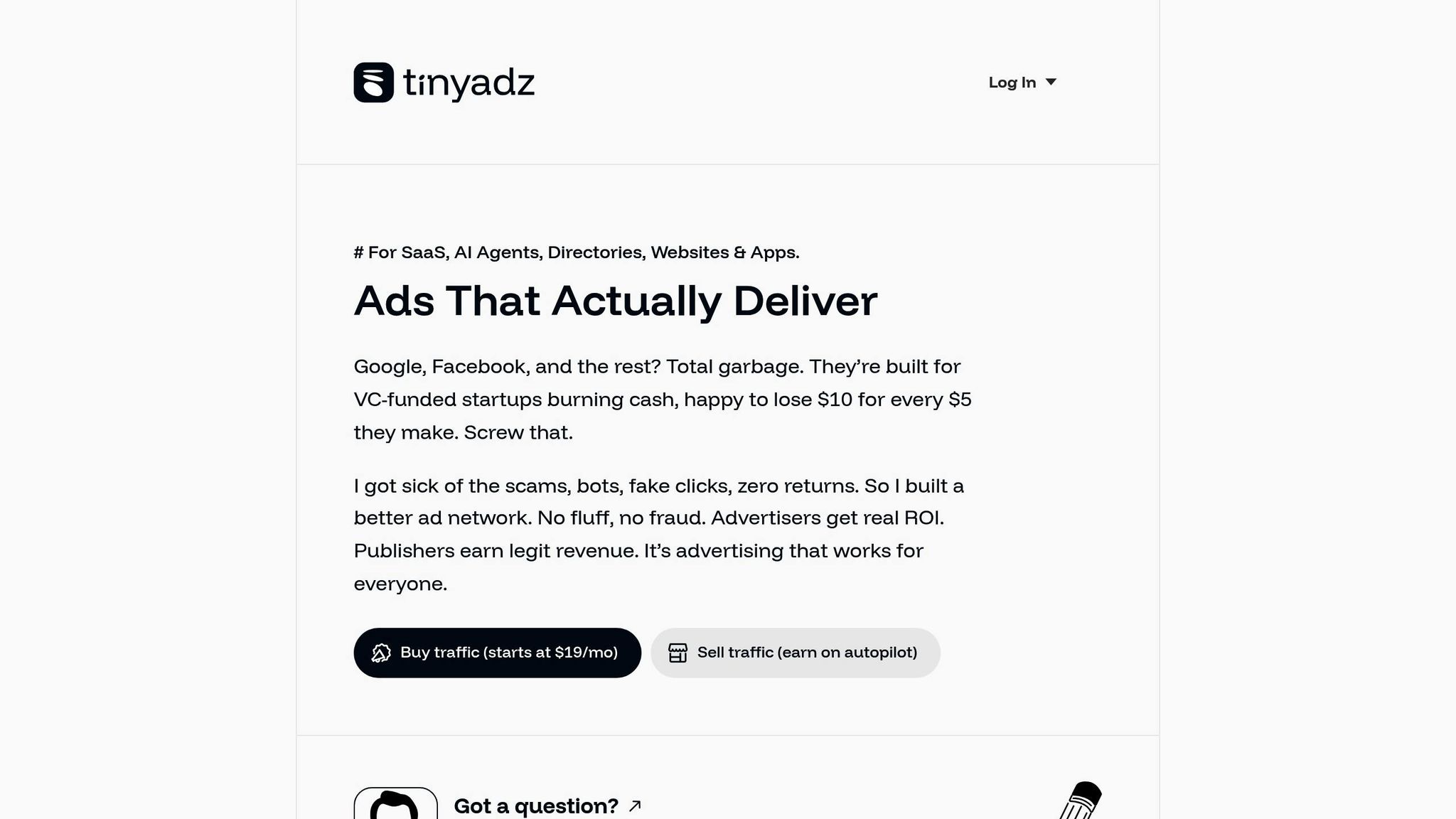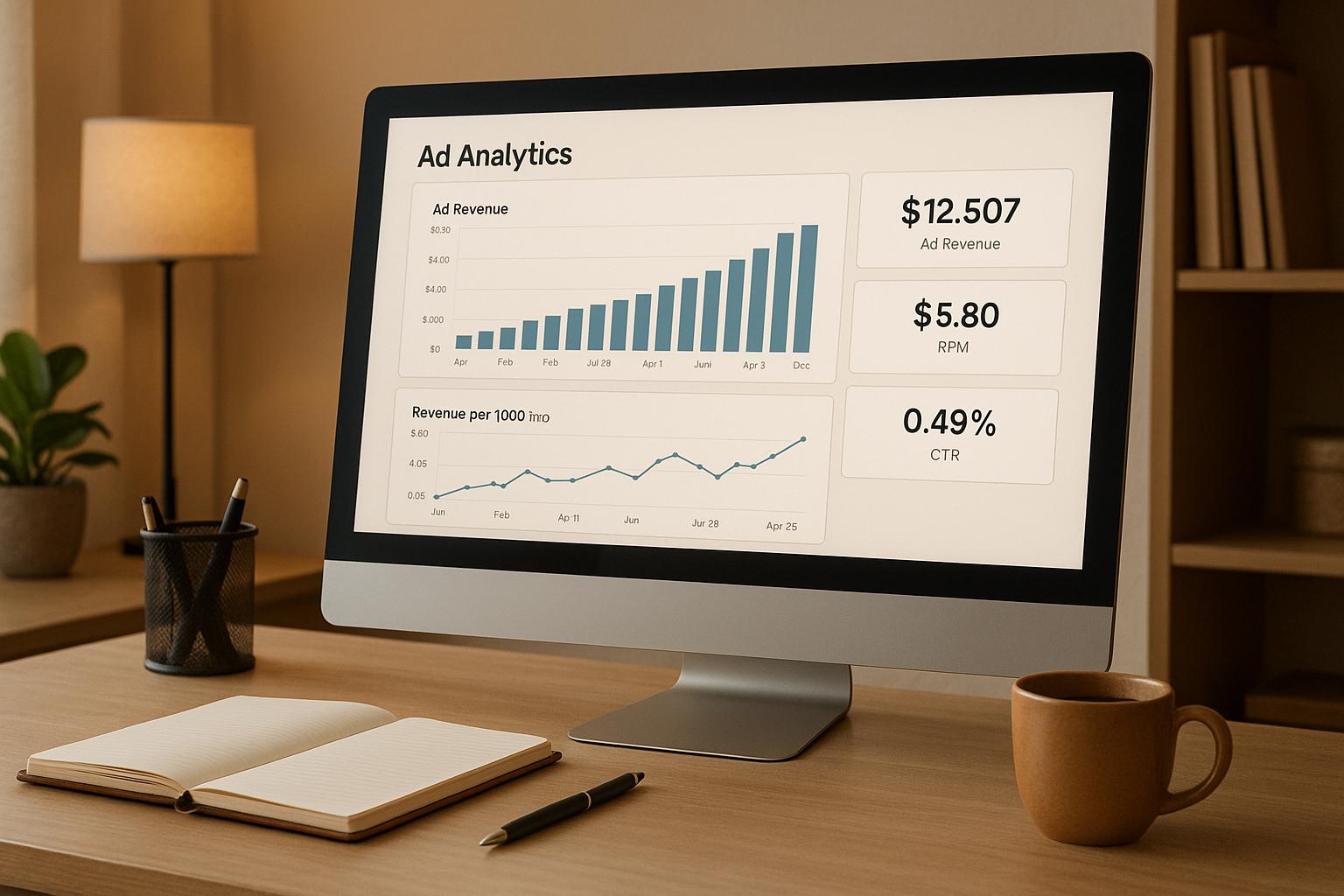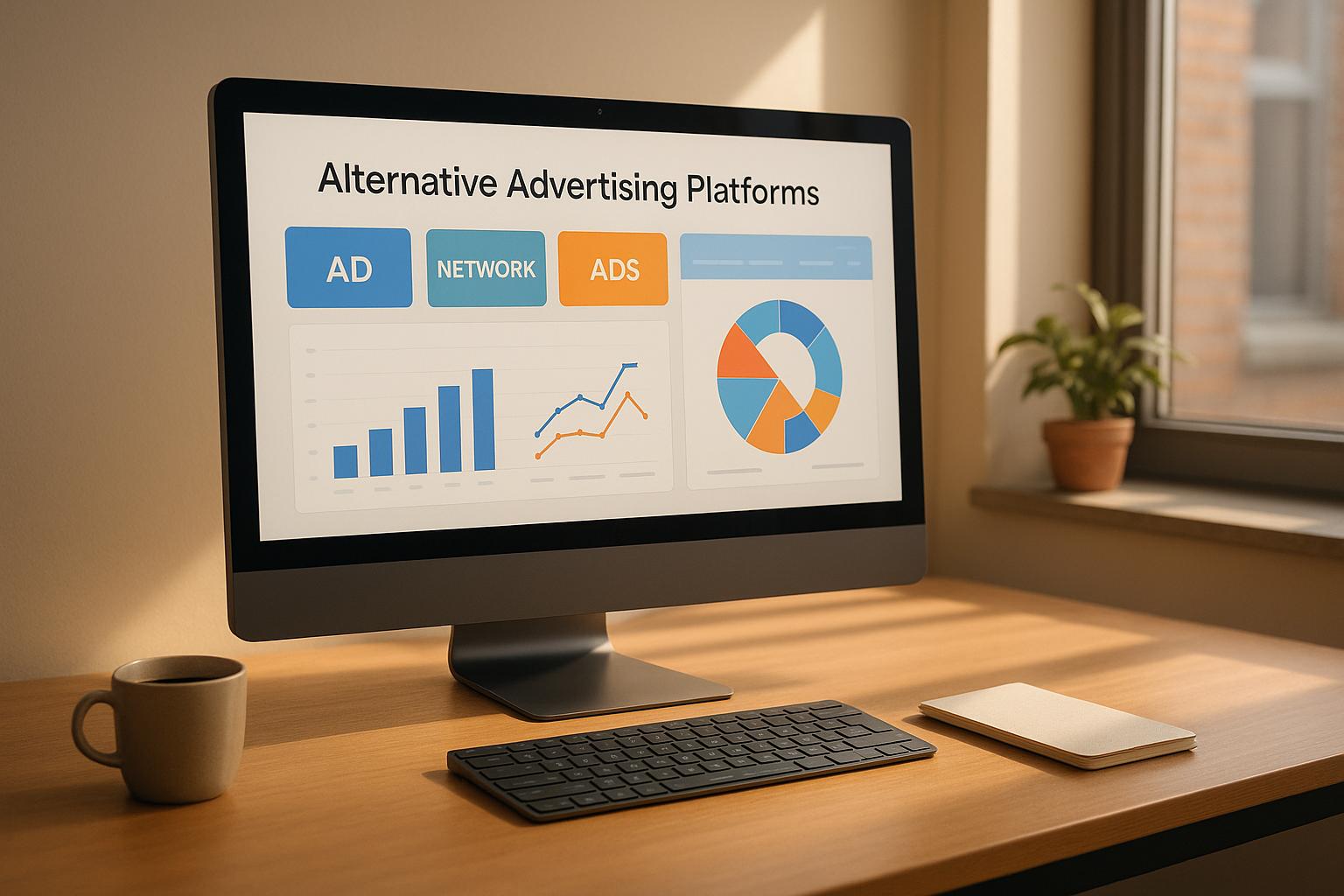Adding ads to your website can help you earn passive income while you focus on creating content. Here’s a quick guide to get started:
- Choose an Ad Type: Options include display ads, programmatic ads, or direct ad sales. Each has different earning models like CPC (cost-per-click) or CPM (cost per 1,000 impressions).
- Prepare Your Website:
- Verify ownership using methods like HTML tags or Google Analytics.
- Ensure your site meets ad platform guidelines (original content, fast load times, mobile-friendly).
- Optimize ad placement for visibility without overwhelming users.
- Pick a Platform: Platforms like TinyAdz make it easy to connect with advertisers, set up ads, and track performance.
- Install Ad Code: Add the provided ad code to your website. Platforms often offer step-by-step guides for WordPress, Shopify, or custom sites.
- Monitor and Improve:
- Use tools like Google Analytics to test and optimize ad placements.
- Track metrics like CTR and CPM to maximize revenue.
- Follow Rules: Ensure compliance with FTC disclosure rules and privacy laws like the CCPA.
Quick Comparison of Ad Types
| Ad Type | Revenue Model | Effort Needed | Best For |
|---|---|---|---|
| Display Ads | CPC or CPM | Low | General websites |
| Programmatic Ads | Automated CPM | Very Low | High traffic sites |
| Direct Ad Sales | High CPM | High | Niche or specific audiences |
Google AdSense | How to Create & Place Ads on your website (Beginner's guide)
Types of Website Advertising
Exploring different advertising options can help you find the best revenue strategy for your website. Each method comes with its own set of advantages, earning potential, and level of control over your ad space.
Display and Banner Ads
Think of display and banner ads as the digital version of magazine ads - they’re visual, eye-catching, and can include text, images, or even videos. These ads appear as users browse your website, blending into the online experience.
In 2021, global spending on display ads surpassed $244 billion. In the US alone, programmatic digital display ad spending is projected to hit $168.02 billion. Your earnings from these ads depend on key factors like the quality of your website content, your audience demographics, traffic volume, and total page views.
There are two main ways you can earn from display ads. With the cost-per-click (CPC) model, you’re paid every time someone clicks on an ad. The cost per mille (CPM) model, on the other hand, pays you for every 1,000 impressions, regardless of whether users interact with the ads. Video ads often outperform static banners, boasting click-through rates that are 18.4% higher.
To maximize revenue from display ads, focus on strategic placement and ongoing optimization. Ads placed in visible areas - without requiring users to scroll - tend to perform better. At the same time, they should naturally fit into your content to maintain a positive browsing experience. Testing different ad formats, sizes, and placements can also help you find what works best.
Programmatic Ad Networks
Programmatic advertising takes the hassle out of buying and selling ad space by automating the process with real-time bidding. Instead of negotiating with advertisers yourself, algorithms handle it all, using tools like machine learning to match the right ads with the right audience.
This method is efficient and scalable. By 2024, programmatic ads are expected to account for 91.3% of US digital display advertising. In fact, over 30% of marketers plan to maintain or increase their investment in programmatic marketing. These ads are tailored to users based on signals like browsing habits and shopping behavior.
While programmatic ads typically generate lower revenue per impression - ranging from $1 to $5 CPMs - their sheer volume and automation can still make them a solid revenue stream. The hands-off nature of programmatic advertising lets you focus on creating content while the system works in the background to optimize ad performance.
"Programmatic is great because it allows us to have more control of our targeting parameters and segments. While direct media buying is good for when you want to run on specific inventory, they are very good at putting together deals that are going to work best for your campaign." - Michael Tonkin, Campaign Analyst
Interestingly, in 2022, about 75% of top marketers used AI to enhance their programmatic advertising and media buying efforts.
Direct Ad Sales
Direct ad sales give you complete control over your ad space. You negotiate directly with advertisers, set your own prices, and decide exactly which ads appear on your site.
This approach can be highly lucrative. Direct ads typically sell for $10 to $20 CPMs, significantly higher than the $1 to $5 CPMs of programmatic ads. Advertisers are willing to pay a premium for guaranteed placement, targeted audiences, and a more personalized experience.
Direct sales work particularly well if your website serves a specific niche audience that advertisers are eager to reach. However, this method requires more effort - you’ll need to find advertisers, negotiate terms, and manage relationships. While it’s more time-intensive than automated options, the higher earnings potential often makes it worthwhile.
"Another important difference is that through direct buy the number of impressions are guaranteed, which could be very important for highly competitive targeting. Also, some niche placements could be available through direct buy only." - Olga Voevodina, Sr. Campaign Analyst
To get the most out of your ad inventory, many experts recommend a layered approach. Start with direct sales for premium placements, then move to programmatic preferred and guaranteed deals. Use private auctions next, and finally, programmatic open auctions to fill any leftover space. This strategy ensures you’re maximizing revenue at every level.
Next, let’s dive into how you can prepare your website to take full advantage of these advertising strategies.
Getting Your Website Ready for Ads
Before you dive into monetizing your website, it’s crucial to ensure that your site meets the necessary technical and content standards. These steps help streamline the ad integration process and set your site up for success.
Verifying Website Ownership
The first step in preparing your site for ads is verifying your ownership. This process helps prevent fraud and protects sensitive advertising data. Depending on your website setup and technical skills, you can choose from several verification methods:
- HTML File Upload: Download a verification file and upload it to your website's root directory. This is straightforward but may not work if you have limited file access.
- HTML Tag Verification: Add a snippet of code to the header of your homepage. This method is reliable but requires basic HTML editing skills.
- Google Analytics Tracking Code: If you’re already using Google Analytics, ownership verification happens automatically when you have access to the account.
- Google Tag Manager: Similar to Google Analytics, this method is seamless if your site uses the Tag Manager snippet.
- Domain Name Provider Verification: Add a DNS record through your domain registrar. While more complex, this method verifies your entire domain, including subdomains and both HTTP and HTTPS versions.
Here’s a quick comparison of these methods:
| Verification Method | Difficulty Level | Best For |
|---|---|---|
| HTML File Upload | Easy | Sites with full file access |
| HTML Tag | Medium | Sites where you can edit HTML |
| Google Analytics | Easy | Sites already using Analytics |
| Google Tag Manager | Easy | Sites already using Tag Manager |
| Domain Provider | Hard | Complete domain verification |
If you’re using platforms like WordPress, Wix, or Shopify, check their documentation. Many of these platforms offer plugins or built-in tools to simplify the verification process.
Meeting Platform Requirements
Once ownership is verified, your website must meet the guidelines set by ad platforms. This includes producing original, high-quality content and avoiding anything inappropriate, illegal, or harmful. Ad platforms also have technical requirements, such as adhering to specific ad dimensions, file types, and load speeds. Most platforms now prefer HTML5 over outdated Flash formats.
Google, for example, uses both AI and human reviewers to assess websites. Your site must pass automated scans and align with human standards. Ads should not interfere with navigation or frustrate visitors trying to access content.
Setting Up Your Website Layout for Ads
Thoughtful ad placement can significantly boost earnings while maintaining a positive user experience. Ads positioned above the fold - the section of the page visible without scrolling - often generate higher impressions. However, overloading this area with ads can feel intrusive.
Ads that naturally blend with your content tend to perform better. Sticky ads, which stay visible as users scroll, can nearly double viewability compared to static ads. Another effective approach is using multisize ad placements, allowing ad platforms to display the most suitable ad size for each impression.
Here are some key tips for layout optimization:
- Limit Ad Density: Keep ad density below 30% to avoid overwhelming users. Too many ads can increase bounce rates and reduce overall earnings.
- Optimize for Mobile: With mobile traffic often surpassing desktop, ensure your ads display properly across various devices and screen sizes. Tools like Google Analytics and heatmap software can help identify high-engagement areas for ad placement.
- Use Lazy Loading: This technique loads ads only when they come into view, improving page speed and user experience.
- A/B Testing: Experiment with different layouts and placements to find the right balance between ad performance and user satisfaction.
How to Add Ads Using TinyAdz

Start earning from your website with TinyAdz, a platform that connects niche publishers with advertisers while focusing on delivering genuine human impressions to real audiences. Here's a quick guide to getting TinyAdz up and running on your site.
Creating Your TinyAdz Account
Getting started is simple. Head to the TinyAdz website, click on "Become a Publisher", and complete the quick sign-up form. TinyAdz stands out by welcoming publishers of all sizes - no minimum traffic requirements here. Instead, they use details about your site's niche and audience demographics to pair you with advertisers that align with your content. Once you're in, you'll get access to a dashboard where you can manage ad placements, track earnings, and tweak your ad preferences.
Choosing Your Ad Formats
After setting up your account, it's time to pick the ad formats that suit your site and audience. TinyAdz offers a variety of options, including:
- Banner ads for traditional websites.
- Directory monetization for listing-based platforms.
- All-site traffic solutions for broader ad coverage.
- Social media monetization, newsletter revenue, and event monetization for other unique needs.
This flexibility allows you to tailor your ad strategy to your site's layout and audience preferences. Plus, you have full control over which ads appear and when, ensuring they remain relevant to your visitors.
Installing Ad Code on Your Website
Once you've chosen your ad formats, TinyAdz provides the code you need to display ads. The system is lightweight, easy to use, and customizable, making it accessible even for those with limited technical know-how.
For instance, if you're using Next.js, you can place the TinyAdz script in your public directory and reference it in your layout file. Ads will display once per session after a 3-second delay. You can customize fonts, colors, and delay settings to ensure the ads blend seamlessly with your site's design.
If you're working with platforms like WordPress, Shopify, or custom HTML sites, TinyAdz offers tailored integration instructions. After completing the setup, test your ads across various devices and browsers to confirm they display properly and don’t affect your site’s performance.
sbb-itb-957fd63
Tracking and Improving Ad Performance
Once your ads are live, the next step is where the magic happens: keeping an eye on how they perform and making smart tweaks. This can significantly boost your revenue while ensuring your audience has a great experience.
Testing Different Ad Placements
Figuring out the best spots for your ads? That’s where A/B testing comes in. This method lets you compare different versions of your site to see which one gets better results. As experts explain, A/B testing is all about showing variations of your website to find the setup that leads to more conversions.
Start by using tools like Google Analytics to pinpoint high-traffic pages or areas where visitors tend to drop off. Heatmaps and click maps can show you exactly where users are focusing their attention. Tools like Google Optimize make it easy to test ad placements, such as comparing ads in the sidebar versus within the content, or banners at the top versus the bottom of a page. The key? Change just one thing at a time to get clear results. These insights will help you make data-driven decisions about where your ads perform best.
Reading Your Ad Performance Data
Once you’ve tested placements, it’s time to dive into the numbers. Metrics like Click-Through Rate (CTR), Cost Per Mille (CPM), and conversion rates are your best friends here.
- CTR tells you if your ad copy and placement are connecting with your audience.
- CPM helps you understand how much revenue you’re making per 1,000 impressions.
- Conversion rates reveal whether users are taking the desired action after clicking your ads.
Platforms like TinyAdz offer real-time dashboards where you can track these metrics and spot trends, such as which days or ad formats bring in more engagement.
"We monitor Google Ads performance on a daily basis, focusing on the client’s KPIs. Usually, within our pool of clients, this is conversions and/or cost per conversion. Ultimately, the key is to test different strategies and adapt based on performance, regardless of the budget size." – Sam Yielder from Squidgy
Keeping Your Website Fast and User-Friendly
Speed matters - both for your revenue and your visitors’ experience. Research shows that if a page takes more than one second to load, bounce rates can double. With mobile devices accounting for 61% of global web traffic in 2024, fast load times across all devices are non-negotiable.
Here’s how to keep things quick:
- Use asynchronous loading for ads and reserve fixed spaces to avoid layout shifts.
- Refresh ads periodically (every 30 to 240 seconds) without reloading the entire page.
- Compress images and use efficient ad designs to reduce load times.
Tools like Google Lighthouse can help you monitor Core Web Vitals and address any performance issues. And don’t forget: keep your ads separate from your content to avoid accidental clicks and maintain trust with your audience.
"It's about being humble... maybe we don't actually know what's best, let's look at data and use that to help guide us." – Dan Siroker
Following U.S. Advertising Rules and Best Practices
Sticking to U.S. advertising rules and best practices is essential for keeping your monetization efforts both effective and trustworthy. Proper ad management not only ensures compliance with regulations but also helps maintain the trust of your audience. The U.S. has strict standards to protect consumers and uphold transparency in advertising. Following these guidelines can save you from legal issues and enhance your credibility.
FTC Disclosure Rules
The Federal Trade Commission (FTC) requires that all advertisements be honest, non-deceptive, and supported by evidence. This means you need to clearly distinguish ads from your original content.
The golden rule? Clear and conspicuous disclosures. Readers shouldn’t have to dig around to figure out what’s sponsored. The FTC states: "The goal is to ensure that consumers can easily spot the disclosure without actively searching for it".
Here’s how to stay on the right side of the rules:
- Use straightforward language like "#Ad" or "#Sponsored." Skip vague terms like "sp", "spon", or "collab."
- Position disclosures prominently - place them at the start of a sponsored post or within the first few lines, where they’re impossible to miss. The FTC’s 2019 guide, Disclosures 101 for Social Media Influencers, explicitly warns against unclear abbreviations.
- Highlight affiliate relationships with clear statements like: "This post contains affiliate links. I may earn a commission if you purchase through these links". Even if you’re reviewing a product you received for free, you must disclose that connection.
The FTC emphasizes personal accountability:
"As an influencer, it's your responsibility to make these disclosures, to be familiar with the Endorsement Guides, and to comply with laws against deceptive ads. Don't rely on others to do it for you." – Federal Trade Commission
Transparency in disclosures also lays the groundwork for responsible data management.
Privacy and Data Protection Rules
Data privacy is no longer just a European concern. In the U.S., laws like the California Consumer Privacy Act (CCPA) are setting the tone, and other states are following suit. If you’re running ads, you’re likely collecting visitor data, which means you need to handle it responsibly.
Why does this matter? Fines for violations can be astronomical. Meta was fined €1.2 billion for mishandling data transfers, Amazon faced a €746 million ($887 million) penalty for tracking users without consent, and Zoom settled for $86 million under the CCPA due to privacy breaches. These aren’t just fines - they’re existential threats to businesses.
Moreover, trust is everything. Three out of four consumers wouldn’t buy from a company they don’t trust with their data. Privacy compliance isn’t just about avoiding penalties - it’s about staying in business.
Here’s what you should prioritize:
- Get explicit consent. Users must clearly agree to data collection, and silence or pre-checked boxes don’t count.
- Keep your privacy policy up to date. It should detail how you collect, use, and share data, including third-party tracking through ad networks.
- Use a consent management platform (CMP). These tools simplify consent collection and ensure compliance with evolving regulations.
As privacy expert Adelina Peltea of Usercentrics puts it:
"More regulations, more data, more systems, more partners, more uses, and more bad actors mean more threats to companies' privacy compliance and data security. Companies need expert management of data and privacy operations, strong security policies and protocols, ongoing staff education, and robust tools to protect themselves and their customers."
Avoiding Bad Advertising Practices
Compliance is only part of the equation. Ethical advertising is equally important for maintaining user trust. Poor advertising practices can erode credibility and drive users away. When trust in a brand increases by just one point, consumer purchase intent jumps by 33%. Every advertising decision impacts your bottom line.
Here’s what to avoid:
- Don’t mislead your audience. Take Volkswagen’s 2015 scandal as a cautionary tale. Marketing diesel cars as eco-friendly while cheating emissions tests resulted in massive fines and lasting reputational damage.
- Avoid being tone-deaf. Pepsi’s 2017 ad featuring Kendall Jenner trivialized social justice movements, sparking backlash and forcing the company to issue public apologies.
- Respect user privacy. Facebook’s Cambridge Analytica scandal in 2018 is a prime example of the fallout from mishandling user data. Millions of users’ information was harvested without consent, leading to lawsuits and a loss of public trust.
- Keep ads separate from content. Users shouldn’t have to guess whether they’re looking at editorial content or paid promotions.
- Don’t overload your site with ads. While it’s tempting to maximize ad placements, too many ads can slow down your site and frustrate visitors. Ethical ad practices contribute to a better user experience.
Remember, advertising should complement - not disrupt - the user experience. Sixty-five percent of consumers believe responsible media practices are the best way to build trust.
As eMarketer’s Insider Intelligence explains:
"Digital trust is the confidence people have that a platform will protect their information and provide a safe environment for them to create and engage with content, including advertising and sponsored content."
Summary and Next Steps
Adding ads to your website doesn’t have to feel overwhelming. You’ve already explored the types of ads available, how to prepare your site, integrate TinyAdz, and track performance - all while ensuring compliance with U.S. regulations. With these essentials in place, you’re ready to move forward.
TinyAdz makes getting started simple with a quick setup process and an easy-to-use dashboard. The platform’s personalized matchmaking feature connects you with advertisers whose products resonate with your audience, boosting click-through rates and creating a better experience for your visitors[58,59].
You’ll also have several monetization options to choose from, such as:
- Banner ads
- Directory monetization
- Social media monetization
- Newsletter revenue
- Event monetization
Next Steps: Sign up for TinyAdz and pick ad formats that complement your content. Use the dashboard to track performance, tweak ad placements, and experiment with various formats to find what works best - all while keeping user experience front and center.
Keep in mind, steady improvement is vital. Marketers who set clear goals achieve success at a rate 377% higher than their peers.
As advertising trends shift, some principles remain constant: deliver value to your audience, follow regulations, and work with platforms that prioritize transparency and high-quality campaigns. TinyAdz ensures your reputation stays intact by avoiding spammy links, bots, and fake impressions.
Start small - test a single ad placement, analyze its performance, and scale up based on real data. Begin your journey to monetization today with TinyAdz.
FAQs
What should I consider when choosing the right type of ads for my website?
Choosing the Right Ad Type for Your Website
To pick the most effective ad type for your website, start by analyzing your audience's habits and preferences. Are your visitors primarily browsing on mobile devices or desktops? This detail matters because mobile-friendly ad formats are a must if most of your traffic comes from smartphones. Ignoring this could mean missing out on better performance.
Next, consider your content focus. If your site is centered around videos, incorporating video ads can boost interaction and keep viewers engaged. On the other hand, for blogs or news sites, native ads are a smart choice since they blend effortlessly with written content, making them feel less intrusive.
Lastly, always keep user experience at the forefront. Ads should fit seamlessly into your website's design, enhancing rather than disrupting navigation or readability. A strategically placed ad can generate revenue while maintaining a positive experience for your visitors.
How can I make sure my website meets ad platform requirements?
To ensure your website aligns with ad platform requirements, focus on a few essential elements:
- Content Standards: Ensure your website's content complies with ad platform policies. Steer clear of harmful, misleading, or inappropriate material that could lead to violations.
- User Experience: Position ads thoughtfully, so they don't interfere with your site's primary content. Choose ad formats that complement the overall user experience rather than detract from it.
- Technical Optimization: Stick to standard ad sizes and formats to ensure they work seamlessly across different devices. Regularly monitor your site to confirm that ads don’t slow it down or negatively impact SEO.
- Privacy Compliance: Adhere to data protection regulations like GDPR. Be transparent about how user data is collected and used to maintain trust.
Following these steps can help ensure compliance and create opportunities to boost your ad revenue.
What are the best ways to optimize ad placement and boost ad performance on my website?
To get the most out of your ad placements and boost performance, focus on a few smart strategies. Start by placing ads in high-visibility spots, like above the fold or near content that grabs attention - this helps improve both visibility and click-through rates. Don’t forget to run A/B tests to figure out which ad formats and placements work best for your specific audience.
Make sure your ads are relevant to your content and audience. This reduces the risk of ad blindness and encourages more engagement. You can take it a step further by personalizing ads through retargeting, making them more appealing to individual users. Finally, strike a balance between ads and content. Ads should complement your site’s usability, not disrupt it, ensuring a smooth and enjoyable experience for your visitors.


